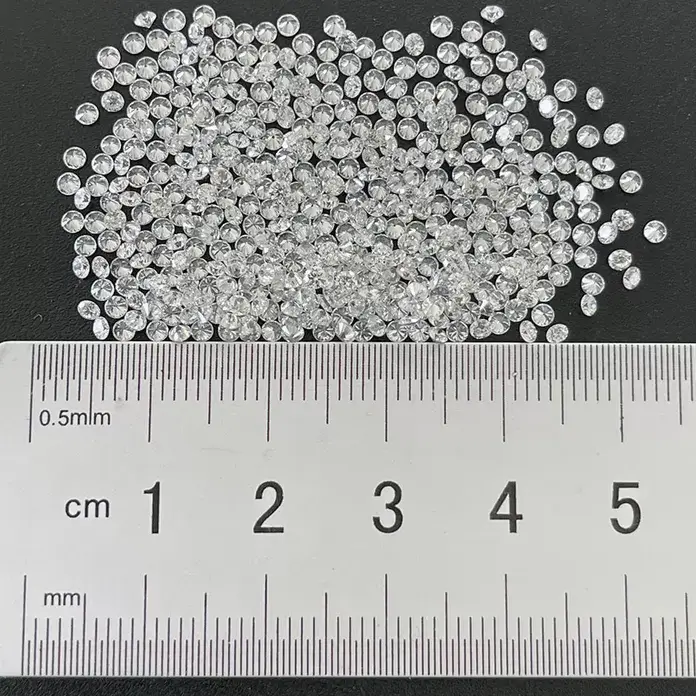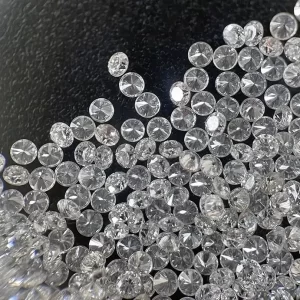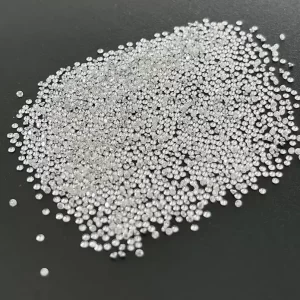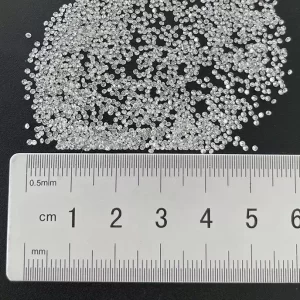DEF VVS VS 1.25mm To 1.35mm Lab Created Melee Diamonds
DEF VVS VS 1.25mm – 1.35mm Lab Created Melee Diamonds For Diamond Watch Making
Lab Created Melee Diamonds Description
Lab-grown diamonds are diamonds grown in the laboratory using equipment that simulate the growth environment of natural diamonds. Both lab grown diamonds and natural diamonds are real diamonds. The main chemical components of lab grown diamonds and natural diamonds are carbon.
Lab grown diamonds is usually produced by chemical vapor deposition (CVD) or high pressure high temperature (HPHT) methods.
The gem-grade synthetic diamond produced by the CVD (chemical vapor deposition) method is beautiful in appearance and has almost the same properties as natural diamonds. Because of their high purity, these CVD products belong to Type IIa, which constitutes only a small portion of natural diamonds. Under the advanced detection technology, any diamond sample using CVD growth method can be clearly identified.
Colorless and almost colorless synthetic diamonds are usually type IIa, while only 2% of natural diamonds are type IIa. Type IIa diamonds are characterized by high purity, and they exhibit transparency in certain parts of the ultraviolet and infrared spectra.
A hydrogen-rich environment can cause defects, called vacancies, because occasionally carbon atoms will leave the diamond crystal, creating vacancies. The carbon vacancy next to the silicon atom can form a silicon vacancy (Si-V) center, which is very rare in nature. The carbon vacancy adjacent to the nitrogen atom can form a nitrogen vacancy (N-V) center, which is very rare in nature. The defects of these two vacancies can be detected by spectroscopic measurements such as photoluminescence, ultraviolet irradiation and light absorption. Since diamond has the characteristics of layer-by-layer formation, and nitrogen is non-uniformly fused between the layers, growth stripes can be observed.
HPHT Lab Created Melee Diamonds
If you are considering purchasing a diamond ring, you might be wondering how HPHT lab grown diamonds are produced. HPHT stands for High pressure, high temperature, and is used to create diamonds that are flawless and fire-reflective. These diamonds are often made into ring settings or other jewelry. There are many advantages to using HPHT lab created diamonds, so let’s take a closer look.
Synthetic diamonds
HPHT or High Pressure Hydrothermal Treatment is a process for creating synthetic diamonds by exposing carbon atoms to high pressures and temperatures. It involves the use of a temperature gradient method to create a diamond. A special container containing carbon, graphite, and catalyst is compressed by a hydraulic press. The high pressure and heat creates a large crystal in a week. The new material is allowed to cool before it takes its final shape.
A new process known as Chemical Vapor Deposition (CVD) is another way to create synthetic diamonds. This process involves creating diamonds from carbon atoms, or CO2 or argon. The carbon is then ionized, breaking the molecular bonds that bind the gases together. As a result, pure carbon adheres to the diamond seed and builds the crystal layer by layer.
While natural diamonds display a mosaic or crosshatched pattern, HPHT lab-grown diamonds usually have a banded strain pattern. These patterns help scientists differentiate HPHT and CVD diamonds. In addition to banded strain patterns, HPHT lab-grown diamonds also exhibit fluorescence. If the two are similar in appearance, then HPHT diamonds are the clear winner. However, you should be aware that HPHT diamonds can sometimes have a blue tint.
Since HPHT labs use high-pressure hydrothermal treatment (HHPHT), the resulting synthetic diamonds are comparable in color and clarity to their natural counterparts. They also do not lose their magnetic properties. In addition, they have an underlying magnetic structure, which is another characteristic of natural diamonds. For these reasons, synthetic diamonds are often the best option for jewelry. You can even buy HPHT diamonds and still save a lot of money!
Using HPHT-technology, Gemesis Corporation began marketing colorless CVD synthetic diamonds in March 2012. Since then, several other companies have entered the market. Gemesis recently sold 16 of its synthetic diamonds to GIA researchers. These diamonds range in size from 0.24 carats to nearly a half carat. They have high colors and have no inclusions, making them more affordable than diamonds in nature.
High pressure high temperature method
The production of HPHT diamonds is growing exponentially, and this technology is being used to produce small, relatively cheap melee diamonds. HPHT diamonds have the highest concentration of iron among all the inclusions, and are therefore virtually weightless. A strong magnet can easily attract melee diamonds, which are much smaller and practically weightless than traditional diamonds. However, unlike natural diamonds, which can only display phosphorescence for a few seconds, HPHT diamonds can sustain this phenomenon for over 50 seconds.
In addition to their low carat weight, the main distinguishing characteristic of a melee diamond is its rarity. The size of these gems means that they are often misidentified as type IIB diamonds. Because they are so small, these gemstones are difficult to handle, and can even be quite ticklish to handle. Therefore, it is important to understand whether a diamond is natural or lab grown before buying it.
The production cycle for puny diamonds takes less than an hour. Most of the material comes from China, and the price of the finished product is only a few cents per carat. Due to their unmatched properties, puny diamonds are now widely used in industrial and scientific applications. They are also used in wire saw blades, diamond drill bits, and medical scalpels. For a long time, it was virtually impossible to grow tiny diamonds.
The HPHT method recreates diamond-forming conditions inside the earth’s crust. High pressure and high temperature are maintained in a reaction vessel inside a “belt”-like apparatus. The process requires a high level of temperature and pressure, as the higher the temperature, the more rapid the growth of diamonds. When the process is finished, the diamond is nearly identical to a natural diamond in its appearance and chemical composition.
The first stage of HPHT is the growth cell. The growth cell contains a mixture of graphite, high-quality carbon, and a catalyst. The catalyst is composed of a metal called cobalt. Nickel and cobalt are also used. Once the growth cycle is completed, the cell is removed from the HPHT machine. The new rough diamond is then cut and polished. The process takes about seven days.
Chemical Vapor Deposition method
The HPHT (High Pressure Hydrogen Peroxide) method is a relatively new way of creating small facetted diamonds. It produces diamonds that are very similar to natural diamonds but are cut much smaller. This method can produce hundreds of thousands of carats per month. While the process is comparatively simple, it is not cost-effective and results in smaller stones that are harder to distinguish from real diamonds.
The CVD process is more complicated than HPHT. It begins with the heating of a diamond plate to 800 0C. In this process, carbon atoms are deposited on the diamond plate. The process can take anywhere from one to four weeks to complete. The growth of a diamond is limited by the size of the diamond plate. The CVD process also requires a lot of time, but the results are worth it.
The HPHT process uses a diamond press to generate a great deal of pressure on a small, central container containing a seed crystal, carbon atoms, and a metallic flux. The heat and pressure cause the carbon atoms to migrate through the flux towards a diamond seed. After a few days or weeks, the carbon atoms crystallize and the diamond grows.
Another feature of HPHT-created diamonds is their phosphorescence. This property is caused by trace amounts of boron. In natural diamonds, this phenomenon is very rare and fleeting. However, HPHT-created diamonds have a high phosphorescence rate and can phosphoresce for up to 50 seconds! While natural diamonds can show this effect, phosphorescence in HPHT lab created diamonds is less common.
Compared to HPHT, CVD-created diamonds are much cheaper. It requires lower energy and fewer sophisticated machinery than the HPHT method. The main difference is the morphology of the finished product. The CVD method has lower costs because it uses plasma. It was used in other industrial applications before being adapted for diamond production. The advantages of CVD over HPHT methods include:
Cost of synthetic diamonds
In September, De Beers ended its decades-long policy of refusing to sell lab-grown diamonds as jewelry. The company began selling gem-quality man-made stones for $800 a carat. Now, that price has dropped to $4,200 – and is likely to stay low. In fact, the company expects to generate $1 billion in profit this year. The company hopes to boost its share of the diamond market by cutting costs further and undercutting rivals.
HPHT diamonds are often marked by metallic inclusions. These inclusions appear black in reflected light and opaque in transmitted light. The flux metal used to create synthetic diamonds contains iron, nickel, and cobalt. These large metallic inclusions are highly magnetic. Natural diamonds do not have these metallic inclusions. Their price will depend on the setting for the jewelry you choose. The type of setting will also determine the cost of synthetic diamonds.
Although the price of lab-created diamonds is often far less than that of natural diamonds, they have similar characteristics. The James Allen lab-created diamond, for example, costs $3,800. That’s a substantial savings compared to a natural diamond. A similar quality diamond could cost you just $50 to sell on eBay. Clearly, the value of lab-grown diamonds will never be the same.
While lab-grown diamond prices are significantly lower than natural diamonds, the market is still relatively new, which means that prices are still not uniform. And unlike natural diamonds, lab-grown diamonds do not have a set baseline price. In the natural diamond market, three companies set the price. Demand and supply dictate prices, while prices for lab-grown diamonds vary greatly between producers. So, the price of synthetic diamonds produced by HPHT labs depends on the size, quality and demand.
Another reason for the cost of synthetic diamonds is the growing influence of digital technologies. These technologies have simplified the creation of man-made diamonds, which has led to decreased prices on the global market. In 2008, one carat of lab-grown diamonds cost $4000. Today, that price has dropped to $300 to $500. If you’re in the market for a diamond, why not consider HPHT Lab created diamonds for your next engagement ring?
DEF VVS VS 1.25mm To 1.35mm Lab Created Melee Diamonds

















